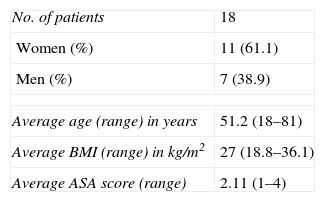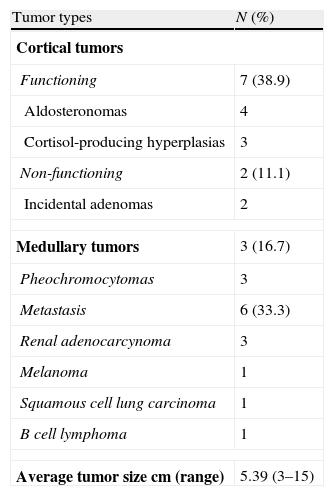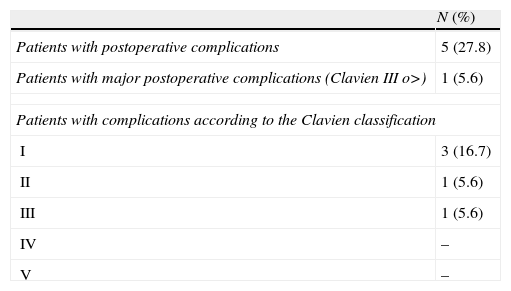We present our initial experience using robotic-assisted laparoscopic adrenalectomy in the surgical treatment of adrenal masses.
Material and methodsA total of 18 patients (11 women and 7 men) diagnosed of a functioning or non-functioning adrenal tumor mass were operated on in our facilities between October 2009 and October 2011. Surgical variables, intra-hospital recovery time, pathological findings and peri- and post-operatory findings were evaluated.
ResultsMean age of the population intervened was 51.2 years (range 18–81), average ASA score 2.11 (range 1–4) and BMI 27.0 (range 18.8–36.1). Of the 18 patients, 11 were operated on the left side and 7 on the right. Mean surgery time was 150 (range 84–329) min and intra-operatory bleeding 121 (range 10–1500) ml, with a mean loss of hemoglobin and hematocrits of 2.11g/dl and 6.33%, respectively. Two patients were converted to conventional surgery. The factors influencing surgical conversion were: normal size (>10cm), tumor weight (>100g), active pheochromocytoma and left localization of the tumor. Seven functioning cortical adenomas, 6 metastatic adrenal tumors, 3 pheochromocytoma and 2 incidental tumors were excised. Mean tumor size was 5.39 (range 3–15) cm. Median hospital stay was 6 days (range 4–14). Five patients had peri-operatory complication. Of these, only one (5%) had major complications (Clavien III). Mean follow-up was 6 months (range 2–24).
ConclusionsRobotic technology for laparoscopic adrenalectomies is a valid option for adrenal tumor treatment. In our experience with a relatively short learning curve, it makes it possible to reduce hospital treatment times and the intra- and post-operatory complications, without affecting the oncological and post-operatory functional results.
Presentamos nuestra experiencia inicial utilizando la adrenalectomía laparoscópica robótica en el tratamiento quirúrgico de las masas suprarrenales.
Material y métodosEntre octubre de 2009 y octubre de 2011 fueron operados en nuestra institución un total de 18 pacientes (11 mujeres y 7 hombres) con diagnóstico de masa tumoral adrenal funcionante o no funcionante. Evaluamos variables quirúrgicas, el tiempo de recuperación intrahospitalario, los hallazgos patológicos y las complicaciones peri y postoperatorias.
ResultadosLa edad media de la población intervenida fue 51,2 años (rango: 18-81), el promedio de puntuación ASA 2,11 (rango: 1-4) y el IMC 27,0 (rango: 18,8-36,1). De los 18 pacientes 11 fueron operados del lado izquierdo y 7 del derecho. El tiempo medio de cirugía fue 150 minutos (rango: 84-329) y el sangrado intraoperatorio 121ml (rango: 10-1.500), con una pérdida media de hemoglobina y de hematocrito de 2,11g/dl y 6,33%, respectivamente. Dos pacientes fueron convertidos a cirugía convencional. Los factores que influyeron en la conversión quirúrgica fueron: tamaño tumoral (>10cm), peso tumoral (>100g), feocromocitoma activo y localización izquierda del tumor. Se extirparon 7 adenomas corticales funcionantes, 6 tumores suprarrenales metastásicos, 3 feocromocitomas y 2 tumores incidentales. El tamaño medio del tumor fue 5,39cm (rango: 3-15). La mediana de la estancia hospitalaria fue de 6 días (rango: 4-14). Un total de 5 pacientes presentaron complicaciones perioperatorias. De éstos solo uno (5%) tuvo complicaciones mayores (Clavien III). El seguimiento medio fue de 6 meses (rango: 2-24).
ConclusionesLa tecnología robótica para la realización de adrenalectomías laparoscópicas es una opción válida para el tratamiento de los tumores suprarrenales. En nuestra experiencia, con una curva de aprendizaje relativamente corta, permite reducir los tiempos de tratamiento hospitalario, así como las complicaciones intra y postoperatorias, sin afectar los resultados oncológicos y funcionales postoperatorios.










